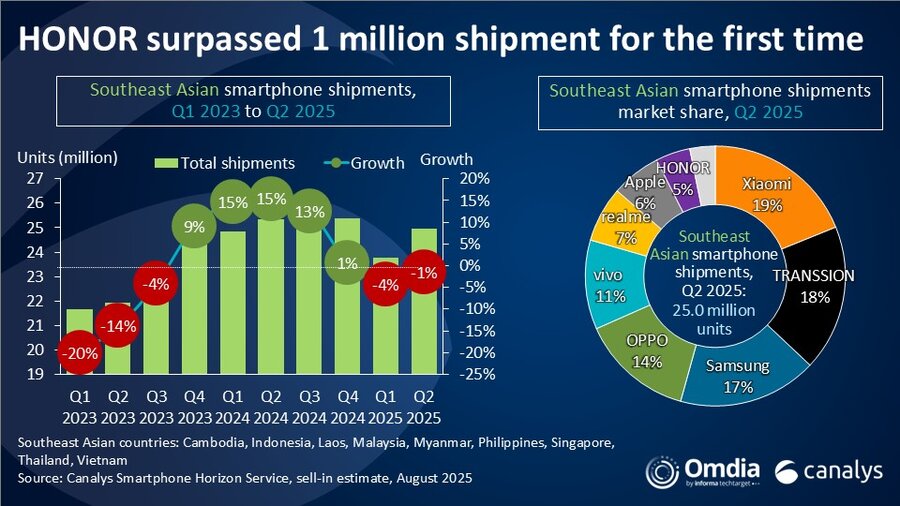Xiaomi regains SEA smartphone crown
August 13, 2025

According to research from Canalys, part of Omdia, Southeast Asia’s smartphone market declined 1 per cent year on year in Q2 2025 to 25 million units, as tariff uncertainty continues to cloud the region’s outlook.
Xiaomi reclaimed the top spot for the first time since Q2 2021, shipping 4.7 million units and capturing a 19 per cent market share, up 8 per cent from a year ago, driven by strong Redmi series sales and expanded channel reach. TRANSSION climbed to second place with 4.5 million units and an 18 per cent market share, recording a robust 17 per cent year-on-year increase on the back of new launches in the entry-level portfolio. Samsung ranked third with 4.3 million units and a 17 per cent market share, down 3 per cent year on year, though demand for its 5G-capable devices grew in markets like Vietnam and Singapore, supported by the improved value proposition of its Galaxy A06 5G and A16 5G models. OPPO (excluding OnePlus) was placed fourth with 3.5 million units and a 14 per cent market share, falling 19 per cent as competition in the entry-level tier intensified. vivo rounded out the top five, shipping 2.8 million units and taking 11 per cent market share, down 21 per cent year on year amid a strategic pivot toward improving profitability.
“The ongoing US/China trade tensions are creating significant knock-on effects, as vendors realign supply chains away from China to prioritise shipments for the US,” said Research Manager Le Xuan Chiew at Canalys, part of Omdia. “This inevitably impacts production and stock allocation from manufacturing hubs such as China and Vietnam to both Southeast Asia and the US, disrupting inventory planning and constraining product availability. At the same time, currency volatility, particularly a weakened US dollar, is influencing local purchasing power and retail pricing, forcing vendors to adjust prices or promotions to remain competitive. Although shipment volumes stayed relatively steady, looming tariff uncertainties and persistent macroeconomic headwinds are dampening consumer sentiment, especially in the mass market segment. Vendors have seen mixed results; some capitalized on agile product and channel strategies, while others struggled amid intensifying competition.”
“In this environment, flexibility in portfolio and channel strategies is proving critical,” added Chiew. “Xiaomi’s Q2 2025 performance was driven by the expansion of its direct-to-consumer and operator channels, creating a solid foundation to scale its sub-brands; POCO shipments more than doubled, while the premium Xiaomi 15 series grew 54 per cent year on year, a milestone for a brand long perceived as a budget flagship. Samsung likewise strengthened channel diversification and premium positioning by expanding its enterprise strategy, an advantage rooted in its legacy as a trusted partner to large enterprises and government sectors. This reflects Samsung’s growing focus on vertical integration and B2B engagement, setting it apart from competitors while supporting higher ASPs and unlocking cross-device revenue beyond traditional retail channels.”
“Differentiating beyond price in the mass market segments is an ongoing challenge for all vendors,” said Senior Analyst Sheng Win Chow at Canalys, part of Omdia. “Xiaomi and TRANSSION are leading in the lower price bands with competitive pricing and aggressive trade push incentives. While competition is fierce at the entry level, some brands are finding success by moving upmarket. A standout premiumisation story is HONOR, whose shipments surged 121 per cent year on year in Q2 2025, surpassing 1 million units for the quarter. The success of higher-priced models like the X9c and 400 series has enabled HONOR to achieve strong volume growth while maintaining significantly higher ASP than competitors. vivo, despite a 21 per cent overall shipment decline, achieved strong momentum in its mid-range portfolio, with the V-series shipment growing 92 per cent year on year to account for nearly 21 per cent of its shipments, up from just 9 per cent in Q2 2024. Capturing a bigger share of the premium mid-range segment helps improve margins and reinforce the long-term viability in a competitive market.”
Other posts by :
- Deutsch Bank reveals targets for AST SpaceMobile
- AST SpaceMobile boss outlines benefits
- Report: LEO build-out accelerates
- Germany outlines space commitment
- Analysis: Impact of AT&T on US telcos and cable
- Bezos rocket production boosted
- Musk delays Moon landing until 2027
- Hughes Satellite facing cash crunch
- Major banks support AST SpaceMobile
